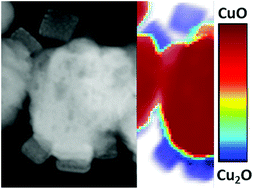Our official English website, www.x-mol.net, welcomes your
feedback! (Note: you will need to create a separate account there.)
How photocorrosion can trick you: a detailed study on low-bandgap Li doped CuO photocathodes for solar hydrogen production
Nanoscale ( IF 5.8 ) Pub Date : 2020/03/18 , DOI: 10.1039/c9nr10250g Jonathan Kampmann 1, 2, 3, 4 , Sophia Betzler 1, 2, 3, 4, 5 , Hamidreza Hajiyani 4, 6, 7, 8 , Sebastian Häringer 1, 2, 3, 4 , Michael Beetz 1, 2, 3, 4 , Tristan Harzer 1, 2, 3, 4 , Jürgen Kraus 4, 9, 10, 11 , Bettina V. Lotsch 1, 2, 3, 4, 5 , Christina Scheu 4, 12, 13 , Rossitza Pentcheva 4, 6, 7, 8 , Dina Fattakhova-Rohlfing 4, 14, 15, 16 , Thomas Bein 1, 2, 3, 4
Nanoscale ( IF 5.8 ) Pub Date : 2020/03/18 , DOI: 10.1039/c9nr10250g Jonathan Kampmann 1, 2, 3, 4 , Sophia Betzler 1, 2, 3, 4, 5 , Hamidreza Hajiyani 4, 6, 7, 8 , Sebastian Häringer 1, 2, 3, 4 , Michael Beetz 1, 2, 3, 4 , Tristan Harzer 1, 2, 3, 4 , Jürgen Kraus 4, 9, 10, 11 , Bettina V. Lotsch 1, 2, 3, 4, 5 , Christina Scheu 4, 12, 13 , Rossitza Pentcheva 4, 6, 7, 8 , Dina Fattakhova-Rohlfing 4, 14, 15, 16 , Thomas Bein 1, 2, 3, 4
Affiliation

|
The efficiency of photoelectrochemical tandem cells is still limited by the availability of stable low band gap electrodes. In this work, we report a photocathode based on lithium doped copper(II) oxide, a black p-type semiconductor. Density functional theory calculations with a Hubbard U term show that low concentrations of Li (Li0.03Cu0.97O) lead to an upward shift of the valence band maximum that crosses the Fermi level and results in a p-type semiconductor. Therefore, Li doping emerged as a suitable approach to manipulate the electronic structure of copper oxide based photocathodes. As this material class suffers from instability in water under operating conditions, the recorded photocurrents are repeatedly misinterpreted as hydrogen evolution evidence. We investigated the photocorrosion behavior of LixCu1−xO cathodes in detail and give the first mechanistic study of the fundamental physical process. The reduced copper oxide species were localized by electron energy loss spectroscopy mapping. Cu2O grows as distinct crystallites on the surface of LixCu1−xO instead of forming a dense layer. Additionally, there is no obvious Cu2O gradient inside the films, as Cu2O seems to form on all LixCu1−xO nanocrystals exposed to water. The application of a thin Ti0.8Nb0.2Ox coating by atomic layer deposition and the deposition of a platinum co-catalyst increased the stability of LixCu1−xO against decomposition. These devices showed a stable hydrogen evolution for 15 minutes.
中文翻译:

光腐蚀如何诱骗您:对用于太阳能氢生产的低带隙锂掺杂CuO阴极的详细研究
稳定的低带隙电极的可用性仍然限制了光电化学串联电池的效率。在这项工作中,我们报道了一种基于锂掺杂铜(II)氧化物,黑色p型半导体的光电阴极。用Hubbard U项进行的密度泛函理论计算表明,低浓度的Li(Li 0.03 Cu 0.97O)导致价带最大值的向上偏移,该价带穿过费米能级并产生p型半导体。因此,Li掺杂出现为控制基于氧化铜的光电阴极的电子结构的合适方法。由于该材料类别在操作条件下会在水中不稳定,因此记录的光电流反复被误解为析氢证据。我们详细研究了Li x Cu 1− x O阴极的光腐蚀行为,并首次对基本物理过程进行了机理研究。还原的氧化铜种类通过电子能量损失谱图定位。Cu 2 O在Li x Cu表面上以独特的微晶形式生长1- x O代替形成致密层。另外,由于在暴露于水的所有Li x Cu 1- x O纳米晶体上似乎都形成了Cu 2 O,所以薄膜内部没有明显的Cu 2 O梯度。通过原子层沉积和Ti助催化剂的沉积施加Ti 0.8 Nb 0.2 O x薄涂层,提高了Li x Cu 1- x O抵抗分解的稳定性。这些设备在15分钟内显示出稳定的氢气释放。
更新日期:2020-04-09
中文翻译:

光腐蚀如何诱骗您:对用于太阳能氢生产的低带隙锂掺杂CuO阴极的详细研究
稳定的低带隙电极的可用性仍然限制了光电化学串联电池的效率。在这项工作中,我们报道了一种基于锂掺杂铜(II)氧化物,黑色p型半导体的光电阴极。用Hubbard U项进行的密度泛函理论计算表明,低浓度的Li(Li 0.03 Cu 0.97O)导致价带最大值的向上偏移,该价带穿过费米能级并产生p型半导体。因此,Li掺杂出现为控制基于氧化铜的光电阴极的电子结构的合适方法。由于该材料类别在操作条件下会在水中不稳定,因此记录的光电流反复被误解为析氢证据。我们详细研究了Li x Cu 1− x O阴极的光腐蚀行为,并首次对基本物理过程进行了机理研究。还原的氧化铜种类通过电子能量损失谱图定位。Cu 2 O在Li x Cu表面上以独特的微晶形式生长1- x O代替形成致密层。另外,由于在暴露于水的所有Li x Cu 1- x O纳米晶体上似乎都形成了Cu 2 O,所以薄膜内部没有明显的Cu 2 O梯度。通过原子层沉积和Ti助催化剂的沉积施加Ti 0.8 Nb 0.2 O x薄涂层,提高了Li x Cu 1- x O抵抗分解的稳定性。这些设备在15分钟内显示出稳定的氢气释放。











































 京公网安备 11010802027423号
京公网安备 11010802027423号